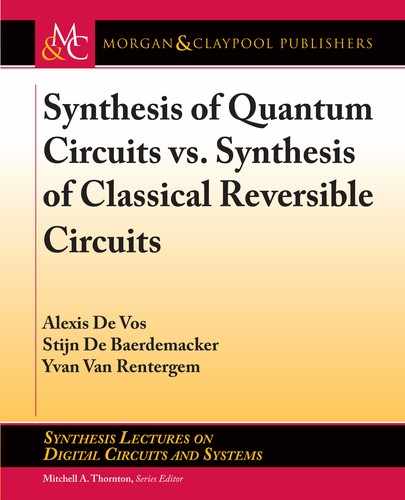
3.1. THE SQUARE ROOT OF THE NOT 51
Table 3.1: e four members of the group with w D 1: (a) IDENTITY, (b) square root of NOT,
(c) NOT, and (d) “other” square root of NOT
?
1
?
2
?
1
?
2
?
1
?
2
?
1
?
2
?
1
?
2
?
1
?
2
?
1
?
2
?
1
?
2
1
0
0
1
? ?
̅
?
̅
?
1 0
0 1
? ?
̅
?
̅
?
1 0
0 1
? ?
̅
?
̅
?
? ?
̅
?
̅
?
0 1
1 0
1 0
0 1
? ?
̅
?
̅
?
0 1
1 0
?
̅
?
? ?
̅
1 0
0 1
? ?
̅
?
̅
?
?
̅
?
? ?
̅
1 0
0 1
(a) (b) (c) (d)
3.1.2 TWO AND MULTI-(QU)BIT CALCULATIONS
According to Section 1.12, two qubits exist in a superposition represented by the column vector
.a
1
a
2
a
3
a
4
/
T
with
P
a
k
a
k
D 1. e states .1 0 0 0/
T
, .0 1 0 0/
T
, .0 0 1 0/
T
, and .0 0 0 1/
T
cor-
respond with the classical bit values .A
1
; A
2
/ equal to .0; 0/, .0; 1/, .1; 0/, and .1; 1/, respectively,
whereas all other (i.e., superposition) states have no classical equivalent.
e wanted set of 2-qubit circuits should contain all classical reversible 2-bit circuits.
ose 4Š D 24 circuits are generated by the two generators g
1
and g
2
(1.5), generating the group
P(4) of 4 4 permutation matrices. e set of 2-qubit circuits we investigate [43] also has to
comprise the circuit calculating the square root of NOT of qubit # 2. is circuit is represented
by the matrix
g
3
D
0
B
B
B
@
0 0
0 0
0 0
0 0
1
C
C
C
A
D
V
:
(3.2)
Besides a gate V, we also introduce
g
4
D
0
B
B
@
1 0 0 0
0 1 0 0
0 0
0 0
1
C
C
A
D
V
;
(3.3)
i.e., a gate which may be interpreted either as a “controlled square root of NOT” or as a “square
root of controlled NOT.”

52 3. BOTTOM-UP
By adding the generators g
3
and g
4
to the set fg
1
; g
2
g, the group P(4) is enlarged
1
to a
new group , which surprisingly has infinite order. We can prove this fact [43] by investigating
one particular element of , i.e.,
y D g
1
g
2
g
4
D
0
B
B
@
0 0
0 1 0 0
0 0
1 0 0 0
1
C
C
A
:
e theory of the Z-transform [43, 44] tells us that the matrix sequence fy; y
2
; y
3
; : : :g is not
periodic. In other words: all matrices y, y
2
, y
3
, …are different. erefore, the order of the
group element y is infinite. erefore the order of the group itself is also infinite. One can
additionally prove [43] that order() is countable. us we may finally conclude that order()
equals @
0
. We again have found a group X satisfying the desired property (1.15):
P.4/ U.4/ ;
with orders
24 < @
0
< 1
16
:
We stress here the difference between the two infinities @
0
and 1, the former being the cardi-
nality of the integers, the latter being the cardinality of the reals.
e members M of are U(4) matrices with all 16 entries M
jk
of the form
1
2
p
.a
jk
C ib
jk
/ ;
where a
jk
and b
jk
are integers, such that a
jk
C ib
jk
is a so-called Gaussian integer and p is a
non-negative integer. We assume that at least one a
jk
or one b
jk
is odd, such that p cannot be
lowered by “simplifying fractions.” We call p the level of the matrix M . For example, the matrix
y
3
D
1
4
0
B
B
@
2i 0 3 i 1 i
0 4 0 0
2 0 1 Ci 3 i
2 2i 0 2 2i
1
C
C
A
is a member of with level 2. Whereas in P(4) all matrices have level 0, in , the matrices can
have any level. Indeed [45], in U(4), there exist as many as
1
In fact, generator g
3
is superfluous, as it can be composed from fg
1
; g
2
; g
4
g:
D
V V V
:
..................Content has been hidden....................
You can't read the all page of ebook, please click here login for view all page.
